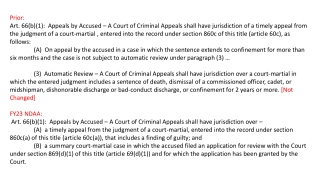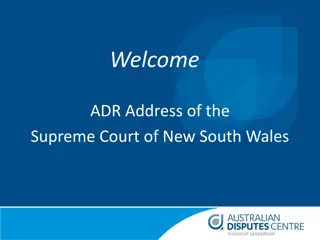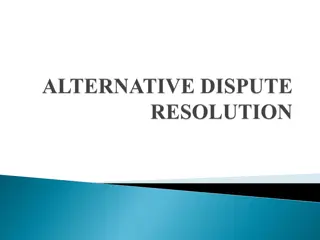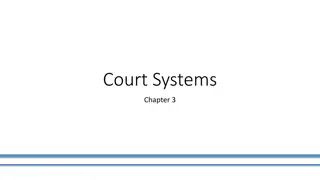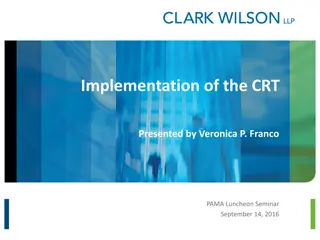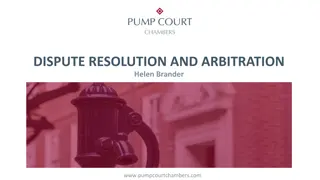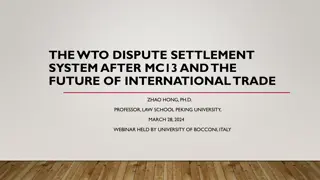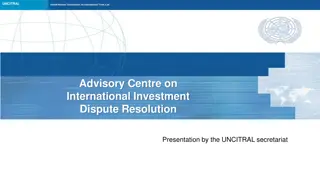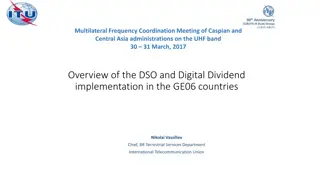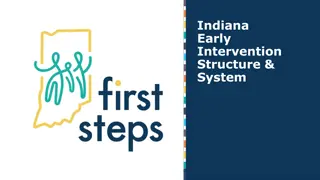The Future of Commercial and Investment Dispute Resolution: The Multilateral Investment Court vs. International Arbitration
International dispute resolution systems, particularly arbitration, face challenges like cost and time efficiency. The Multilateral Investment Court (MIC), proposed by the EU, aims to replace traditional ISDS systems and provide a permanent multilateral court for investment disputes. The MIC incorporates features of domestic and international courts to enhance transparency and judicial independence.
Download Presentation

Please find below an Image/Link to download the presentation.
The content on the website is provided AS IS for your information and personal use only. It may not be sold, licensed, or shared on other websites without obtaining consent from the author.If you encounter any issues during the download, it is possible that the publisher has removed the file from their server.
You are allowed to download the files provided on this website for personal or commercial use, subject to the condition that they are used lawfully. All files are the property of their respective owners.
The content on the website is provided AS IS for your information and personal use only. It may not be sold, licensed, or shared on other websites without obtaining consent from the author.
E N D
Presentation Transcript
THE INAUGURAL JUSTICE JONNY HAVELOCK LECTURE THE FUTURE OF COMMERCIAL AND INVESTMENT DISPUTE RESOLUTION: THE MULTILATERAL INVESTMENT COURT v. INTERNATIONAL ARBITRATION DR. W. A MUTUBWA, OGW LL.D C.Arb FCIArb
INTRODUCTION In the recent past, the international dispute resolution system has come under scrutiny and criticism. The challenges reflected upon have been a necessary shock to the system, forcing us to reflect on the place and efficiency of international arbitration as we chart the way forward. The future of international commercial and investment dispute resolution is therefore a topic of ongoing debate and evolution. According to various reports published by established institutions and organizations, international arbitration remains the go to mode of dispute resolution for commercial disputes. Major arbitration institutions such as the LCIA, SIAC, HKIAC, ICC and CIARB have recorded increases in the number of cases under their administration. There has also been remarkable and robust jurisprudence on arbitration showing a strong support from the judiciaries round the world. While these reports highlight the continued popularity of international arbitration, they also highlight the challenges that face the practice such as costs, time and confidentiality in arbitrations involving states and state departments.
The Lord Chief Justice of England and Wales, Lord Thomas in 2016 noted that arbitration faces three problems: first, the limitation of appeals to courts on arbitral decisions is unduly severe, secondly that unreported arbitral awards create uncertainty in law as common law is largely dependent on precedent and finally that more commercial cases should therefore be allowed to go to court and openly decided. The foregoing and more challenges continue to ignite the discussions around the future of international arbitration more specifically around ISDS. Concerns on ISDS have been raised regarding issues such as consistency in arbitral decisions, arbitrator impartiality, lengthy proceedings, and potential bias towards investors especially in ISDS. Moreover, confidentiality of arbitration has been under siege in cases involving states with public interest militating in favour of publicity as highlighted in the case of Nigeria v. P&ID by Justice Knowles. Viable alternative options continue to be explored under different auspices and the MIC has been touted in this respect in order to address some of arbitration s shortcomings.
What is the MIC? The MIC is the EU s brainchild introduced during the UNCITRAL s Working Group III discussions. The EU s objective in suggesting the creation the Multilateral Investment Court is to replace the bilateral investment court systems included in its trade and investment agreements. The Multilateral Investment Court would be a permanent multilateral court established to decide investment disputes. It aims to depart from the traditional investor-to-state dispute settlement (ISDS) system based on ad hoc commercial arbitration by incorporating features of both domestic and international courts into investment adjudication. The key aspects of the Multilateral Investment Court include having a first instance tribunal, an appeal tribunal, tenured and highly qualified judges adhering to strict ethical standards, a dedicated secretariat, transparency in operations, ruling on disputes under existing and future investment treaties, enforcing decisions effectively, and preventing disputing parties from selecting judges for their case.
Advantages of the MIC over International Investment Arbitration The MIC aims to improve on the shortcomings of international arbitration in various ways which in essence highlight its advantages over arbitration as it currently stands; Consistency and Predictability: The MIC aims to enhance the predictability and consistency of decisions in investor-state disputes. By having a standing mechanism with full-time adjudicators, the MIC can ensure a more uniform approach to interpreting investment laws and treaties. Impartiality and Independence: The MIC addresses concerns about impartiality by having salaried adjudicators who are not influenced by the parties involved in the dispute. This reduces the risk of conflicts of interest and enhances the perceived neutrality of the decision-makers. Reduced Costs and Duration: One of the criticisms of traditional ISDS is the high costs and lengthy duration of proceedings. The MIC s streamlined process with permanent adjudicators could potentially lead to quicker resolutions and lower overall costs for both investors and states. Appellate Mechanism: The MIC includes an appellate tribunal to review errors of law or egregious factual errors, providing an additional layer of scrutiny and ensuring that decisions are legally sound.
Qualifications of Adjudicators: The proposal for the MIC suggests that adjudicators should have qualifications comparable to those in other international courts like the International Court of Justice. This ensures that cases are heard by experienced professionals with expertise in international investment law. Reduction of Double-Hatting: By requiring full-time adjudicators who cannot act as counsel in other matters during their term, the MIC minimizes ethical concerns related to double-hatting, where arbitrators act as both advocates and decision-makers. Enhanced Enforcement Mechanisms: While it is not entirely clear how MIC judgments would be enforced, having a structured court system may provide more robust enforcement mechanisms compared to traditional ad hoc arbitration. Global Acceptance: If established successfully, an MIC could potentially gain widespread acceptance among states, creating a unified approach to resolving investment disputes globally. Addressing Criticisms of ISDS: The MIC seeks to address many of the criticisms leveled against traditional ISDS systems, such as lack of transparency, inconsistency in decisions, and concerns about arbitrator bias.
Shortcomings of the MIC Whereas there is support for this reform from entities like the EU itself and other global north countries, some countries and actors have expressed opposition. Concerns have been raised about potential political bias affecting adjudicators in a permanent multilateral court. Compromised accuracy It has been argued that in its attempt to address the problem of consistency and predictability, the MIC may compromise on accuracy. The concern is that while aiming for consistency, it might overlook ensuring accuracy in decision-making. This issue was exemplified by similar dispute resolution systems such as the WTO as shown by the USA blocking new appointments in the World Trade Organization (WTO) due to concerns about binding interpretations going against agreements. The second concern with the current structure of the MIC is that achieving consistency might be challenging due to the vast number of treaties signed by different countries with varying wordings. This diversity in agreements could make it difficult for adjudicators to apply consistent interpretations across cases. Limitations on access to the MIC Like the ISDS before it, the MIC seems to limit access to only foreign investors which means that people or countries affected by investors would not have access to international legal instruments for recourse. This aspect raises questions about fairness and inclusivity within the proposed system.
Potential bias and ineffectiveness of the arbitration system under the MIC. There are apprehensions that this system could leave individuals and environmental concerns vulnerable to decisions made in favor of international investors without adequate consideration for broader societal interests. In summary, while the MIC proposal aims to address some of the challenges faced by traditional ISDS systems, there are significant concerns regarding its ability to ensure accuracy, achieve consistency, promote fairness and inclusivity, mitigate bias, enforce decisions equitably, and fundamentally reform investor-state dispute resolution practices. In essence, the MIC might not be the one stop shop for all the challenges facing the ISDS as it comes with its own concerns.
WHICH WAY FORWARD? While the fate of the ISDS system might be hanging on a balance, international commercial arbitration on the other side continues to grow in bounds albeit some challenges of its own that might be common with investment arbitration. Ultimately therefore, the future of both international commercial and investment dispute resolution has to contend with several key and common trends and challenges. Some of these challenges include costs, delay, excessive formality, and arbitrator neutrality. Additionally, issues such as arbitration ethics, diversity, transparency, data protection movements, the rise of settlement agreements, and international commercial courts have gained greater urgency in the field of international arbitration as posed by some of the trends I highlight below. Moreover, the increasing complexity of international arbitration requires legal professionals to adopt an interdisciplinary approach, possess multi-jurisdictional expertise, language skills, and cultural awareness.
TRENDS IN ARBITRATION TODAY Technological advancements - Technology has not only affected business realties but also continues to impact on the type disputes that will be resolved as well as the way dispute resolution will conducted. The COVID 19 Pandemic for instance necessitated us to rethink our commercial justice systems to embrace technology by adapting to virtual proceedings, e-discovery tools and document management systems. Disruptive technologies such as Generative Artificial Intelligence (AI), and machine learning technologies also continue push the limits of dispute resolution as we know it. The adoption of digital currencies across different jurisdictions, smart contracts and distributed ledger technology will enable digital trade in every imaginable economic sector. In essence this will disrupt not only discovery of evidence in dispute resolution but also the need for special expertise and understanding in all these technologies to be able to deliver justice accordingly. Third Party Funding - The cost implications of international arbitration have seen the adoption of third-party funding (TPF). Not only have rules been enacted to adapt thereto but there is increasing need for due diligence on funders, party representatives as well as arbitrators in order to reduce conflicts of interest as well as maintain ethical purity of arbitration are some of the emerging concerns and trends. Moreover, the need for skilled negotiation of funding agreements to ensure maximum protection and benefit has also been on the rise. The ability to therefore navigate the challenges posed by TPF in arbitration will in a way demonstrate whether arbitration rises to the challenge and maintains its credibility.
ESG - Environmental, social, and governance (ESG) factors are also gaining importance in international arbitration. Legal professionals as well as arbitration practitioners must now understand ESG principles and compliance requirements to address these factors effectively in dispute resolution processes. Soft skills such as negotiation, mediation, communication, persuasion, cultural sensitivity, and emotional intelligence are now essential for navigating the complexities of international disputes therefore demonstrating the dynamic environment of dispute resolution as it is now and the foreseeable future. There is also the continuing competition between states to become more attractive dispute resolution jurisdictions. This competition often cited as the battle of the seats has seen countries modernize their arbitration laws to respond to some or all the foregoing trends. Moreover, more arbitration centres have been established as the number of disputes continue to rise. The future of arbitration in this respect therefore presents another opportunity for continued collaborations between practitioners, the business community and governments in order to succeed and the prize will therefore likely go those that are likely to adapt fast and appropriately.
Finally, the unity of courts and arbitral tribunals/arbitrators has never been as important as it is now looking into the future. The unity of Courts and arbitral tribunals plays a crucial role in promoting arbitration in an evolving world and navigating challenges. Courts and arbitral tribunals work together to ensure not only the effectiveness and enforceability of arbitration agreements and awards but also credibility of the whole system. Creating and ensuring an enabling judicial system will contribute to the efficiency of the arbitral process both before, during and after arbitrations.
EMERGING INTERVENTIONS The foregoing trends highlight some of the current issues that international arbitration has to contend with besides the shortcomings of investor-state arbitration. In essence, the future of international arbitration remains promising as long as we remain vigilant to current trends and challenges and demonstrate the willingness to adapt. Various interventions have been made in this regard as highlighted below;
1. LEGISLATION Through legislative measures, jurisdictions have been able to navigate some of the challenges and trends highlighted in order to adapt. Departure from cut-and-paste approach of the UNCITRAL Model. Countries are customizing provisions to suit their situations. E.g Tanzania s Permanent Sovereignty Actreturns adjudication of disputes involving Tanzania s natural resources to Tanzania. South Africa has resorted to domestic arbitrations of all disputes moving away from ISDS. Nigeria s Arbitration and Mediation Act of 2023 has established a legal framework that enhances the transparency, speed, autonomy, and enforceability of arbitral awards and mediation settlement agreements while also proving for regulation of third party funding. It has also limited court intervention by creating an Award Review Tribunal which has been hailed as preserving the tenets of arbitration. The Sierra Leone Arbitration Act, 2022 entails extensive provisions on the jurisdiction of the arbitral tribunal, appointment of emergency arbitrators and interim measures and modern elements of international arbitration like Third Party Funding. AfCFTA/ PAIC The PAIC draft provides for an arbitration mechanism to be conducted at any established African public or alternative dispute resolution center if member states agree to. UNCITRAL WORKING GROUPS Various groups have undertaken substantive preparatory work on topics on UNCITRAL's work program such as costs of arbitration, virtual proceedings, third party funding in international arbitration, issues of calculation and assessment of damages etc
ICSID Rules 2022 Came to force on 1st July, 2022 bringing with them among others provisions relating to public hearings and disclosure of third party funding arrangements. The rules are designed to make the administration of ICSID cases more efficient and transparent and therefore somehow dispel some of the problems ailing ISDS. Increased Diversity in international arbitration Statistics show that in the five years from 2015 to 2021, the proportion of women appointed as arbitrator almost doubled, from 12.6% to 26.1%. (The ICCA Taskforce Report 2020). There are deliberate efforts and interventions to ethnic and cultural diversity through various policies and initiatives.
CONCLUSION Ultimately, the future of international investment dispute resolution may involve a combination of these mechanisms or other innovative solutions. Nations must carefully weigh the merits and demerits of each approach based on their specific needs and priorities. The dialogue surrounding these mechanisms reflects a transitional phase in international investment law where balancing state sovereignty with investor confidence is crucial for global economic progress. Moreover, there are significant gains to be made for the jurisdiction and practitioner that adapts to the current trends in international arbitration. There is therefore need to strategically position international commercial and investment arbitration to respond adequately to rising criticisms and trends in order to deliver justice in a timely, efficient and acceptable manner.


